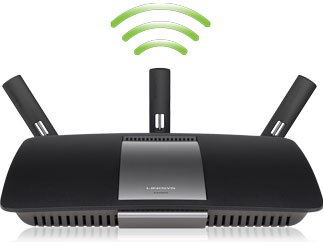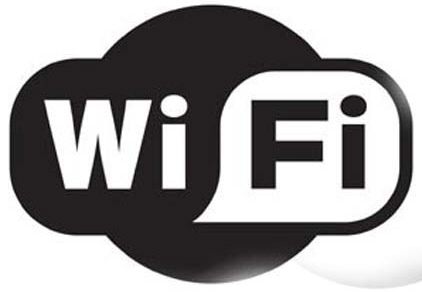main |
sidebar
 your cable or home phone provider, you can buy a wireless router that uses the WiFi standard, and if your computer has a WiFi network card, you'll be able to connect your computer to the router and thereby connect to the Internet! In the case of the wireless printer example, the printer is not connected to the Internet, so the wireless connection you're making is simply to allow your computer to communicate with your printer to avoid the need to use a cable.
your cable or home phone provider, you can buy a wireless router that uses the WiFi standard, and if your computer has a WiFi network card, you'll be able to connect your computer to the router and thereby connect to the Internet! In the case of the wireless printer example, the printer is not connected to the Internet, so the wireless connection you're making is simply to allow your computer to communicate with your printer to avoid the need to use a cable.
What does Wi-Fi stand for?
 You'll often read that it stands for "Publish PostWireless Fidelity," however, that's actually not the case. It's actually said to be a play on words to mirror the commonly used term "Hi-Fi," and is simply a more consumer friendly term referring to the wireless networking IEEE 802.11 technology. There are a number of version of this standard that you may have heard of, including 802.11a, 802.11b, 802.11g, and 802.11n. Generally speaking, these represent different speeds and security standards. Newer versions are typically backwards compatible, which means that if you buy an 802.11.g router, it will still work with your older computer than may only have the 802.11b standard. The same logic applies to prepaid WiFi, as prepaid is simply a payment option.
You'll often read that it stands for "Publish PostWireless Fidelity," however, that's actually not the case. It's actually said to be a play on words to mirror the commonly used term "Hi-Fi," and is simply a more consumer friendly term referring to the wireless networking IEEE 802.11 technology. There are a number of version of this standard that you may have heard of, including 802.11a, 802.11b, 802.11g, and 802.11n. Generally speaking, these represent different speeds and security standards. Newer versions are typically backwards compatible, which means that if you buy an 802.11.g router, it will still work with your older computer than may only have the 802.11b standard. The same logic applies to prepaid WiFi, as prepaid is simply a payment option.
Pakimagic provides you information about the most updated and stylish Cell Phones,Computers.HD Tv,Digital Cameras ,DvD Player,Paki Fashion Models and....................
Popular Posts
-
Beautiful Mehndi Stage Here is a very beautiful and mehndi stage with a variety of mehndi plates. Mehndi stage...
-
Now in Asian Countries there is trend of Contrast makeup especially for bridal makeup. These bridal makeup collections are one of them. Th...
-
Pakistan Latest Fashion Trends & StylesFashion trends in Pakistan come and go, but a good fashion sense stays with you forever. Differe...
-
Tagged Under : Beautiful Pakistani Models Pictures, cybil model, cybil model in pakistan, cybile picture, hot cybil, hot pakistani model...
-
Zaira Batool belongs to Lahore . Zaira completed her graduation six months ago and now is doing her MBA online from Manche...
-
Every teenager wants a fun, flirty look; the easiest way is to have cute teen hairstyles. Any hair style has the potential to be cute: long...
-
Pakistani brides (or in general desi brides) tend to wear their hair long for their weddings - be it a bridal updo hairstyle or wearing it ...
Blog Archive
-
▼
2010
(114)
-
▼
April
(17)
- Nokia E63
- AT&T Palm Pre Plus and Pixi Plus cell phone
- New T-Mobile Sidekick Cell Phone
- Klipsch Shines – An Audio and Solid State Lighting...
- WRT (With Respect To) Technology
- Wifi Router in Pakistan
- The Pentop Computer – interactive pen that talks t...
- Panoptic C-Thru 3D Video Surveillance System
- The Fraunhofer Multimedia Dome
- The first commercially available Brain Computer I...
- The 3D air-mouse you wear as a ring May 21, 2007 ...
- The first commercial Brain Computer Interface Th...
- TrueTouch touchscreen solution Cypress Semicondu...
- Mouse Computer Masterpiece Powered By Core i7 and ...
- BARCODE SCANNING SYSTEM We use mobile technology a...
- Rent Ultra Portable notebooks
- MiFi – 3G Converted to WiFi
-
▼
April
(17)
Category
- LATEST COMPUTER (26)
- latest Digital Cameras (9)
- Latest DVD Player (5)
- Latest HD Tv (15)
- Latest Microwave Oven (5)
- LATEST MOBILES (33)
- Latest Pakistani Fashion (31)
- New Technology (13)
- Paki Domain Name Registration Company List (2)
- Paki Fashion Models (39)
- PAKI HOSTING DOMAIN COMPANIES LIST (2)
- paki mobile companies (2)
- Pakistan Beautiful (5)
- Pakistan Hotels list (1)
- Pakistan ISPs List (1)
- Pakistani Furniture (3)
One important thing to keep in mind is that WiFi in and of itself is not the Internet. It's basically a wireless protocol (or standard) that allows you to connect, or network, two devices together. So, if you have an Internet connection with
 your cable or home phone provider, you can buy a wireless router that uses the WiFi standard, and if your computer has a WiFi network card, you'll be able to connect your computer to the router and thereby connect to the Internet! In the case of the wireless printer example, the printer is not connected to the Internet, so the wireless connection you're making is simply to allow your computer to communicate with your printer to avoid the need to use a cable.
your cable or home phone provider, you can buy a wireless router that uses the WiFi standard, and if your computer has a WiFi network card, you'll be able to connect your computer to the router and thereby connect to the Internet! In the case of the wireless printer example, the printer is not connected to the Internet, so the wireless connection you're making is simply to allow your computer to communicate with your printer to avoid the need to use a cable.What does Wi-Fi stand for?
 You'll often read that it stands for "Publish PostWireless Fidelity," however, that's actually not the case. It's actually said to be a play on words to mirror the commonly used term "Hi-Fi," and is simply a more consumer friendly term referring to the wireless networking IEEE 802.11 technology. There are a number of version of this standard that you may have heard of, including 802.11a, 802.11b, 802.11g, and 802.11n. Generally speaking, these represent different speeds and security standards. Newer versions are typically backwards compatible, which means that if you buy an 802.11.g router, it will still work with your older computer than may only have the 802.11b standard. The same logic applies to prepaid WiFi, as prepaid is simply a payment option.
You'll often read that it stands for "Publish PostWireless Fidelity," however, that's actually not the case. It's actually said to be a play on words to mirror the commonly used term "Hi-Fi," and is simply a more consumer friendly term referring to the wireless networking IEEE 802.11 technology. There are a number of version of this standard that you may have heard of, including 802.11a, 802.11b, 802.11g, and 802.11n. Generally speaking, these represent different speeds and security standards. Newer versions are typically backwards compatible, which means that if you buy an 802.11.g router, it will still work with your older computer than may only have the 802.11b standard. The same logic applies to prepaid WiFi, as prepaid is simply a payment option.
Labels: New Technology
Subscribe to:
Post Comments (Atom)
Template Designed by SkinCorner | Sponsored by GosuBlogger
Copyright © 2009 Complicated Girl. All Rights Reserved.
Copyright © 2009 Complicated Girl. All Rights Reserved.








0 comments:
Post a Comment